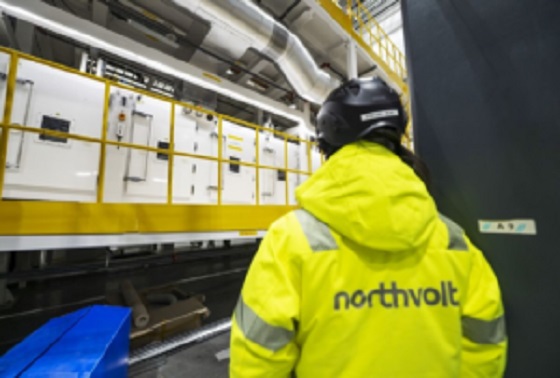Automotive
The Northvolt Crash and What it Says About the State of the Electric Vehicle Market

From Energy Now
By Jim Warren
Northvolt, a wannabe electric vehicle (EV) battery manufacturing superstar, based in Sweden filed for Chapter 11 bankruptcy protection in the US on November 21, 2024. In just eight years the company had blown through $15 billion USD in startup capital. Bloomberg says it was one of the most indebted companies to file for bankruptcy in the US in 2024.
Northvolt promised to be everything green transition crusaders could hope for in a company. And it isn’t surprising the “whiz kids” in the Prime Minister’s Office and the environment ministry made sure Canada got in on the action. According to Bloomberg, Canada made pledges amounting to $7.3 billion CAD ($5.4 billion USD) in loans, equity stakes and subsidies for Northvolt.
Canada’s investments included support for the construction of four electric vehicle (EV) battery factories—one in B.C., two in Ontario and one in Quebec. As of today, only a cockeyed optimist could believe those four plants will be churning out batteries any time soon, if ever.
Northvolt was supposed to be a cutting-edge EV battery innovator. It had the cachet of companies claiming to be implementing next-generation technology. When the company was launched in 2016 it was hailed as Europe’s flagship entry into the international race to produce enough non-Chinese batteries to support a widely anticipated boom in electric vehicle demand in Europe and North America.
For eight years Northvolt rode the wave of green propaganda that accompanied government regulations phasing out the production of vehicles with internal combustion engines. The company further endeared itself with environmentalists by claiming it would be at the forefront of development for the mammoth batteries required to back up solar and wind power generation.
The Economist reports that prominent Wall Street players like BlackRock, Goldman Sachs and JPMorgan Chase ditched any aversion they might have had for getting into business with governments. They contributed to the $15 billion in startup money. Governments got on the Northvolt band wagon. Northvolt received $5 billion USD in grants from five countries: Canada, the European Union (EU), Poland, Germany and of course Sweden.
Private investors weren’t deterred by the fact governments had “picked a winner.” They actually liked the fact governments were backing Northvolt. They assumed the governments of wealthy countries dedicated to Net Zero by 2050, would patiently nurse Northvolt through its growing pains and back it financially when setbacks arose. Risks would be minimized—success was as close to guaranteed as anyone could hope to expect.
Governments in Europe as well as Canada had been busy implementing policies designed to reduce CO2 emissions and combat climate change. Building EV batteries dovetailed nicely with those goals. It was a virtuous circle of mutually reinforcing virtue signaling.
Around the same time it was becoming fashionable for businesses to adopt the principles of Environmental, Social and Governance (ESG). “Progressive” investors including union pension funds required companies they invested in to adopt the goals of environmental sustainability, diversity, equity and inclusion—the core missions of ESG.
Some of Europe’s car makers got behind Northvolt. They wanted to see a vertically integrated European EV industry developed to better withstand competition from cheaper Chinese imports. VW, BMW and Scania AB pre-ordered $50 billon USD worth of Northvolt’s products.
By the fall of 2024, Northvolt already had at least one foot planted on a banana peel. But that didn’t prevent 24 lenders including JPMorgan Chase from throwing it a $5 billion USD lifeline. According to The Economist, this was the biggest “green loan,” ever made in Europe. It apparently wasn’t big enough to prevent the company from filing for Chapter 11 protection.
Odd as it seems in hindsight, private sector investors had embraced a project led by politicians, bureaucrats and research scientists with little to no experience in commercializing their lab experiments. The company’s inability to meet the technical challenges of increasing production to the point of commercial viability was one of the reasons it failed. It turns out it is hard to transform next-generation technology from ideas that work in a test tube into something that makes money.
Ironically, it is car makers from China who are best placed to capitalize on Northvolt’s downfall and dominate Europe’s EV and battery markets. Without tariff support European and North American automakers simply won’t be able to compete with the less expensive government-subsidized Chinese made models.
In 2015 the Chinese government launched its ambitious “Made in China 2025” project. Under the program the government has plowed hundreds of billions into industries that combine digital technology and low emissions technologies. The EV sector was one of the program’s big success stories. Last year, BYD a Chinese manufacturer, overtook Tesla to become the world’s biggest EV producer.
This past November The Economist reported, Chinese auto makers already account for two-thirds of global EV production. They had sold 10 million of them in the previous year. Chinese manufacturers also made 70% of the EV batteries produced globally in 2024. Big investments in factory automation in Chinese EV plants have increased per worker productivity, reducing manufacturing costs.
Government subsidies combined with manufacturing know-how succeeded in creating the world’s most significant EV and EV battery manufacturing industries in China but similar efforts in Europe and North America (e.g. Northvolt) are struggling. It is embarrassing to realize China has become the world’s largest manufacturer and exporter. The West has been left in the dust when it comes to making things like solar panels and EVs.
Europe’s car makers are pressing their governments to limit the number of Chinese made EVs sold in Europe. Yet some EU member states like Germany are reluctant to antagonize China by putting tariffs on its EVs—many German manufacturers rely on access to the Chinese market.
EV sales declined by 5% across Europe in 2024 and high prices for European models are one of the factors responsible for declining sales. Allowing cheaper Chinese EVs into Europe tariff-free should improve EV sales making it more likely that governments’ emissions targets are met. But that makes it more likely that some European car makers will struggle to remain profitable. If large numbers of auto workers are laid off in Europe it will signify the breaking of a major promise made by environmentalists and governments. They have consistently assured people the green transition would create more than enough new green jobs, to make up for job losses in high emissions industries.
The bad news for EV champions extends beyond Europe. Donald Trump has signed an executive order killing federal grants to consumers purchasing electric vehicles. Getting rid of the Biden administration’s EV subsidies should give internal combustion engines a new lease on life. You have to wonder how Trump squared that move with Elon Musk. Perhaps Trump’s promise of tariffs on Chinese goods has been enough to satisfy Tesla. It helps that many EV purchasers in the US prefer big luxury models since the Chinese don’t make too many electric Hummers.
Here in Canada, the Liberal government has said it will cease subsidizing EV purchases as of March 31. It looks more and more like the wheels are coming off the Trudeau-Guilbeault environmental legacy.
While the EV markets in Europe and North America are on shaky ground it is unlikely Northvolt will find the investors required for another last minute bailout. That’s good news for people concerned about Canada’s fiscal health–the Liberals won’t be able to blow any more money on Northvolt if it doesn’t exist.
Automotive
Power Struggle: Governments start quietly backing away from EV mandates

From Resource Works
Barry Penner doesn’t posture – he brings evidence. And lately, the evidence has been catching up fast to what he’s been saying for months.
Penner, chair of the Energy Futures Institute and a former B.C. environment minister and attorney-general, walked me through polling that showed a decisive pattern: declining support for electric-vehicle mandates, rising opposition, and growing intensity among those pushing back.
That was before the political landscape started shifting beneath our feet.
In the weeks since our conversation, the B.C. government has begun retreating from its hardline EV stance, softening requirements and signalling more flexibility. At the same time, Ottawa has opened the door to revising its own rules, acknowledging what the market and motorists have been signalling for some time.
Penner didn’t need insider whispers to see this coming. He had the data.

Barry Penner, Chair of the Energy Futures Institute
B.C.’s mandate remains the most aggressive in North America: 26 per cent ZEV sales by 2026, 90 per cent by 2030, and 100 per cent by 2035. Yet recent sales paint a different picture. Only 13 per cent of new vehicles sold in June were electric. “Which means 87 per cent weren’t,” Penner notes. “People had the option. And 87 per cent chose a non-electric.”
Meanwhile, Quebec has already adjusted its mandate to give partial credit for hybrids. Polling shows 76 per cent of British Columbians want the same. The trouble? “There’s a long waiting list to get one,” Penner says.
Cost, charging access and range remain the top barriers for consumers. And with rebates shrinking or disappearing altogether, the gap between policy ambition and practical reality is now impossible for governments to ignore.
Penner’s advice is simple, and increasingly unavoidable: “Recognition of reality is in order.”
- Now watch Barry Penner’s full video interview with Stewart Muir on Power Struggle here:
Automotive
The high price of green virtue

By Jerome Gessaroli for Inside Policy
Reducing transportation emissions is a worthy goal, but policy must be guided by evidence, not ideology.
In the next few years, the average new vehicle in British Columbia could reach $80,000, not because of inflation, but largely because of provincial and federal climate policy. By forcing zero-emission-vehicle (ZEV) targets faster than the market can afford, both governments risk turning climate ambition into an affordability crisis.
EVs are part of the solution, but mandates that outpace market acceptance risk creating real-world challenges, ranging from cold-weather travel to sparse rural charging to the cost and inconvenience for drivers without home charging. As Victoria and Ottawa review their ZEV policies, the goal is to match ambition with evidence.
Introduced in 2019, BC’s mandate was meant to accelerate electrification and cut emissions from light-duty vehicles. In 2023, however, it became far more stringent, setting the most aggressive ZEV targets in North America. What began as a plan to boost ZEV adoption has now become policy orthodoxy. By 2030, automakers must ensure that 90 per cent of new light-duty vehicles sold in BC are zero-emission, regardless of what consumers want or can afford. The evidence suggests this approach is out of step with market realities.
The province isn’t alone in pursuing EV mandates, but its pace is unmatched. British Columbia, Quebec, and the federal government are the only ones in Canada with such rules. BC’s targets rise much faster than California’s, the jurisdiction that usually sets the bar on green-vehicle policy, though all have the same goal of making every new vehicle zero-emission by 2035.
According to Canadian Black Book, 2025 model EVs are about $17,800 more expensive than gas-powered vehicles. However, ever since Ottawa and BC removed EV purchase incentives, sales have fallen and have not yet recovered. Actual demand in BC sits near 16 per cent of new vehicle sales, well below the 26 per cent mandate for 2026. To close that gap, automakers may have to pay steep penalties or cut back on gas-vehicle sales to meet government goals.
The mandate also allows domestic automakers to meet their targets by purchasing credits from companies, such as Tesla, which hold surplus credits, transferring millions of dollars out of the country simply to comply with provincial rules. But even that workaround is not sustainable. As both federal and provincial mandates tighten, credit supplies will shrink and costs will rise, leaving automakers more likely to limit gas-vehicle sales.
It may be climate policy in intent, but in reality, it acts like a luxury tax on mobility. Higher new-vehicle prices are pushing consumers toward used cars, inflating second-hand prices, and keeping older, higher-emitting vehicles on the road longer. Lower-income and rural households are hit hardest, a perverse outcome for a policy meant to reduce emissions.
Infrastructure is another obstacle. Charging-station expansion and grid upgrades remain far behind what is needed to support mass electrification. Estimates suggest powering BC’s future EV fleet alone could require the electricity output of almost two additional Site C dams by 2040. In rural and northern regions, where distances are long and winters are harsh, drivers are understandably reluctant to switch. Beyond infrastructure, changing market and policy conditions now pose additional risks to Canada’s EV goals.
Major automakers have delayed or cancelled new EV models and battery-plant investments. The United States has scaled back or reversed federal and state EV targets and reoriented subsidies toward domestic manufacturing. These shifts are likely to slow EV model availability and investment across North America, pushing both British Columbia and Ottawa to reconsider how realistic their own targets are in more challenging market conditions.
Meanwhile, many Canadians are feeling the strain of record living costs. Recent polling by Abacus Data and Ipsos shows that most Canadians view rising living costs as the country’s most pressing challenge, with many saying the situation is worsening. In that climate, pressing ahead with aggressive mandates despite affordability concerns appears driven more by green ideology than by evidence. Consumers are not rejecting EVs. They are rejecting unrealistic timelines and unaffordable expectations.
Reducing transportation emissions is a worthy goal, but policy must be guided by evidence, not ideology. When targets become detached from real-world conditions, ideology replaces judgment. Pushing too hard risks backlash that can undo the very progress we are trying to achieve.
Neither British Columbia nor the federal government needs to abandon its clean-transportation objectives, but both need to adjust them. That means setting targets that match realistic adoption rates, as EVs become more affordable and capable, and allowing more flexible compliance based on emissions reductions rather than vehicle type. In simple terms, the goal should be cutting emissions, not forcing people to buy a specific type of car. These steps would align ambition with reality and ensure that environmental progress strengthens, rather than undermines, public trust.
With both Ottawa and Victoria reviewing their EV mandates, their next moves will show whether Canadian climate policy is driven by evidence or by ideology. Adjusting targets to reflect real-world affordability and adoption rates would signal pragmatism and strengthen public trust in the country’s clean-energy transition.
Jerome Gessaroli is a senior fellow at the Macdonald-Laurier Institute and leads the Sound Economic Policy Project at the BC Institute of British Columbia
-

 MAiD2 days ago
MAiD2 days agoFrom Exception to Routine. Why Canada’s State-Assisted Suicide Regime Demands a Human-Rights Review
-

 Business2 days ago
Business2 days agoCarney government should privatize airports—then open airline industry to competition
-

 Alberta2 days ago
Alberta2 days agoCarney’s pipeline deal hits a wall in B.C.
-

 Business2 days ago
Business2 days agoWhat’s Going On With Global Affairs Canada and Their $392 Million Spending Trip to Brazil?
-

 Alberta1 day ago
Alberta1 day agoAlberta Sports Hall of Fame Announces Class of 2026 Inductees
-

 Censorship Industrial Complex1 day ago
Censorship Industrial Complex1 day agoConservative MP Leslyn Lewis slams Liberal plan targeting religious exemption in hate speech bil
-

 Business2 days ago
Business2 days agoIs Carney Falling Into The Same Fiscal Traps As Trudeau?
-

 Energy1 day ago
Energy1 day agoCanada following Europe’s stumble by ignoring energy reality







